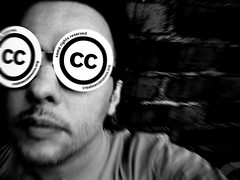
A photo by Franz & P (Franz Patzig) that won the Creative Commons weekly Swag Photo Contest in 2006.
Five years ago I introduced Creative Commons to the team that would become SixEstate and it rapidly became a standard tool for us. The wealth of materials available for the mere price of attribution, not to mention the stuff available to remix, is a blogger’s best friend. Now Creative Commons has upped the ante after two years of open and transparent refinement and released a new version of their license suite. You can view the evolution of the CC licenses here at License Versions.
The Electronic Frontier Foundation, which uses CC licenses on all its works, summarized the changes:
Version 4.0 accomplishes some ambitious goals, but sticks to the spirit of earlier licenses, so that it shouldn’t disrupt existing uses. In several places, the text has been clarified to better reflect the way the public uses the licenses in practice. The attribution requirements, for example, have been slightly adjusted to better accommodate the way re-users are typically providing attribution, by expressly allowing attribution to come in the form of a link to a separate ‘credits’ page.
Among the most notable changes, version 4.0 breaks with the earlier practice of ‘porting’ licenses to different jurisdictions, and is now designed to work all over the world. In the same vein, Creative Commons will provide official translations of the license deeds so that licensors and licensees can read the text in the local languages.
Not Just Content
The implications of this change are larger than they would seem at first. While most people merely think of audio, video, and text in regard to CC, it is also used for software, and pretty much anything else that is subject to copyright (including databases in Europe, although DBs cannot be copyrighted stateside). Puneet Kishor, Creative Commons project coordinator for Science and Data, noted as much in a recent comment:
That means a database creator in the EU, or any other jurisdiction where SGDR might exist, can use a CC4 license allowing use of the database without the user worrying about violating any database rights. In other words, using CC4 relieves the creator from separately licensing database rights, and it relieves the downstream database user — in particular if located in a region where SGDR apply — from worrying about violating any database rights.
You can read a full interview with Kishor on the Public Library of Science website if you’d like a more detailed examination of CC and its use in the sciences.
For content creators who use CC elements in their work, a blog post using a CC image for instance, there are some pretty important changes now in place, changes that offer a much greater degree of flexibility.
Anonymity
For one thing provisions for anonymity have been refined and expanded. The new 4.0 version of the licenses now makes allowances for when the creator of a work wants to distance himself or herself from how that work has been reused. Under the new license the creator has the right to disassociate themselves from use of their works they object to, for instance a photographer whose image gets used by a political party he or she opposes. The work in question does not need to have been published in a collection or modified for this to be the case.
Violations
For the blogger who might make a mistake, as we all do sooner or later, there is now a 30 day window in which to correct it. All Creative Commons licenses are terminated when a licensee breaks the terms. Under the 4.0 version of the licenses , licensees’ rights are reinstated automatically if they fix the violation within 30 days of discovering it. This means that an accident does not cause you to lose usage right to the work in question, as long as you rectify the error in a timely fashion. Under the prior version of the licenses those rights were irrevocably and permanently lost.
Longevity
The updated licenses are a huge step toward another goal of the 4.0 license suite: a flexible and robust array of options arrayed in such a fashion that they should be able to support the needs of new users and uses for many years without requiring any major version updates. Version 3.0 lasted five years; I wonder how long Version 4.0 will make it.
Image by Franz & P (Franz Patzig)